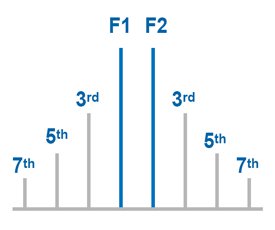Bob VK2ZRE has forwarded the following info regarding a Passive Intermodulation (PIM) distortion – Bob adds:
This article may (should) be of interest to our members. This is yet another mention and “explanation” of the “rusty bolt” effect.
In short, thanks to Keysight Technologies (emphasis mine) – Passive intermodulation (PIM) is a form of intermodulation distortion that occurs in passive components such as antennas, cables, connectors, or duplexers with two or more high-power input signals. PIM in the transmission path degrades quality of the wireless communication system.
PIM is becoming a critical parameter recently due to installation of new technologies in wireless communication industries such as higher RF transmission power, multiband operation with a shared common antenna, or wider bandwidth signals with higher probability of PIM in the receiver band.
The article Bob has supplied is from Pasternack Enterprises who provide Low PIM cable assemblies, connectors, adapters, antennas and tappers designed to address applications where PIM can be an issue. Note that this info is aimed at RF Engineers who work with LTE networks.
Pasternack writes:
 What is PIM?
What is PIM?
PIM, or Passive Intermodulation, is a type of signal distortion that has become increasingly important to detect and mitigate since LTE networks are particularly sensitive to it.
PIM is created when there are two or more carrier frequencies exposed to non-linear mixing. The resulting signal will contain additional, unwanted frequencies or intermodulation products. As the “Passive” portion of the name implies, this non-linear mixing does not involve active devices and is frequently caused by the metallic materials and workmanship of the interconnects and other passive components in the system. Examples of causes of non-linear mixing:
- Imperfect electrical connections: surfaces are never perfectly smooth so the areas of contact can have high current densities which can cause heating through a restricted conduction path causing a resistance change. For this reason connectors should always be tightened to the correct torque.
- Most metal surfaces have at least a thin layer of oxide which can cause tunnelling, or simply cause a reduced area of conduction. Some believe that this produces the Shottky effect. This is why a rusty bolt or metal roof near a cell tower can produce a strong PIM distortion signal.
- Ferromagnetic material: materials such as iron can generate large PIM distortion and should not be used in cellular systems.
As wireless networks become more complex with multiple technologies and system generations in use at a single site, the signals combine to generate this undesired distortion, which interferes with the LTE signals. Antennas, diplexers, cables, and dirty or loose connectors can be sources of PIM, as well as damaged RF equipment or metal objects near or at a distance from the cell site.
PIM interference can have substantial impacts on the performance of LTE networks, which is why it is so important to wireless operators and their contractors to be able to test for, locate and mitigate PIM. Acceptable PIM levels vary by system but as an example Test Company Anritsu said that drive tests have found an 18% drop in download speeds when PIM levels were increased from -125 dBm to -105 dBm, even though the latter number can be considered an acceptable PIM level.
Where is PIM tested?
Individual components are often tested for PIM both in the design and production processes in order to ensure that they are not significant PIM sources once they are installed – however, installation is still a critical piece of PIM mitigation because proper connections are critical. In the case of distributed antenna systems, in some instances the system is tested for PIM as well as individual components. PIM-certified equipment is becoming more common. Antennas, for example, may be PIM-certified to a level of -150 dBc and those requirements are increasingly strict.
PIM is also assessed during the siting process for cellular sites, ideally before the cell site and antennas are placed as well as during the installation process.
